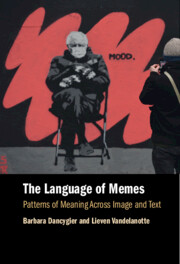
-
Select format
-
- Publisher:
- Cambridge University Press
- Publication date:
- September 2025
- September 2025
- ISBN:
- 9781108950855
- 9781108844352
- Dimensions:
- (229 x 152 mm)
- Weight & Pages:
- 0.54kg, 266 Pages
- Dimensions:
- Weight & Pages:
You may already have access via personal or institutional login
Book description
Internet memes have been studied widely for their role in establishing and maintaining social relationships, and shaping public opinion, online. However, they are also a prominent and fast evolving multimodal genre, one which calls for an in-depth linguistic analysis. This book, the first of its kind, develops the analytical tools necessary to describe and understand contemporary 'image-plus-text' communication. It demonstrates how memes achieve meaning as multimodal artifacts, how they are governed by specific rules of composition and interpretation, and how such processes are driven by stance networks. It also defines a family of multimodal constructions in which images become structural components, while making language forms adjust to the emerging multimodal rules. Through analysis of several meme types, this approach defines the specificity of the memetic genre, describing established types, but also accounting for creative forms. In describing the 'grammar of memes', it provides a new model to approach multimodal genres.
Reviews
‘This book is a real treasure trove for anyone interested in the language and semiotics of new media and digital culture, especially from a cognitive perspective. It expands the scope of cognitive linguistics in the most fascinating way and takes it into the twenty-first century with new multimodal data, new concepts, and a fresh theoretical framework.’
Alexander Bergs - Professor of English Language and Linguistics, Osnabrück University
‘What a joy! Memes seem such simple social media artifacts of the digital age. And yet Dancygier and Vandelanotte, by focusing their unique skills of linguistic analysis, reveal complex visual and textual patterns in memes. Along the way, we are shown that in spite of their deceptive simplicity, memes incorporate multimodal constructions, build discourse spaces, and exhibit recursion - we learn that memes pack a powerful conceptual punch in a small package. This is a thoroughly readable and enlightening book. Enthusiastically recommended for anyone interested in language, social media, the graphic and verbal arts.’
Sherman Wilcox - Distinguished Professor Emeritus, Department of Linguistics, University of New Mexico
Contents
Metrics
Altmetric attention score
Full text views
Full text views help Loading metrics...
Loading metrics...
* Views captured on Cambridge Core between #date#. This data will be updated every 24 hours.
Usage data cannot currently be displayed.
Accessibility standard: WCAG 2.1 AA
Why this information is here
This section outlines the accessibility features of this content - including support for screen readers, full keyboard navigation and high-contrast display options. This may not be relevant for you.
Accessibility Information
The PDF of this book complies with version 2.1 of the Web Content Accessibility Guidelines (WCAG), covering newer accessibility requirements and improved user experiences and achieves the intermediate (AA) level of WCAG compliance, covering a wider range of accessibility requirements.
Content Navigation
Table of contents navigation
Allows you to navigate directly to chapters, sections, or non‐text items through a linked table of contents, reducing the need for extensive scrolling.
Index navigation
Provides an interactive index, letting you go straight to where a term or subject appears in the text without manual searching.
Reading Order and Textual Equivalents
Single logical reading order
You will encounter all content (including footnotes, captions, etc.) in a clear, sequential flow, making it easier to follow with assistive tools like screen readers.
Short alternative textual descriptions
You get concise descriptions (for images, charts, or media clips), ensuring you do not miss crucial information when visual or audio elements are not accessible.
Visual Accessibility
Use of colour is not sole means of conveying information
You will still understand key ideas or prompts without relying solely on colour, which is especially helpful if you have colour vision deficiencies.
Structural and Technical Features
ARIA roles provided
You gain clarity from ARIA (Accessible Rich Internet Applications) roles and attributes, as they help assistive technologies interpret how each part of the content functions.

